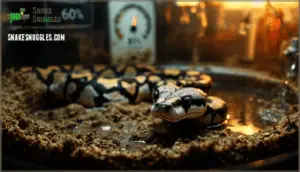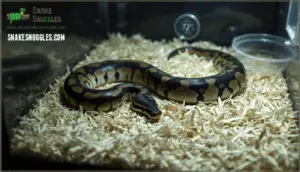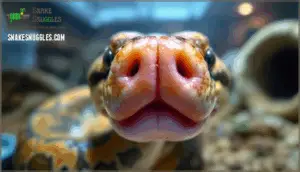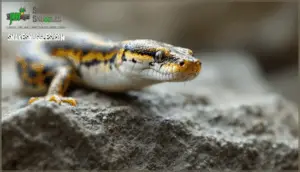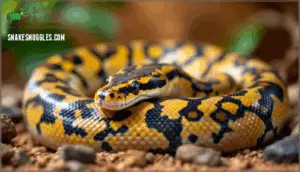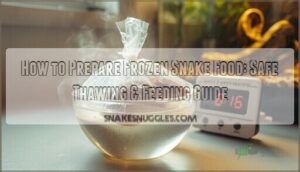This site is supported by our readers. We may earn a commission, at no cost to you, if you purchase through links.

These subtle shifts often slip under the radar, especially for new keepers. Spotting signs of an unhealthy ball python early can mean the difference between a quick recovery and a serious health crisis. The clues are there, and learning to read them gives you the upper hand.
Table Of Contents
- Recognizing Unhealthy Ball Pythons
- Common Signs of Unhealthiness
- Prevention and Treatment
- Specific Health Issues and Solutions
- Observation and Care
- Frequently Asked Questions (FAQs)
- How do you know if a ball python is dying?
- How do you know if a ball python is sick?
- Why is my ball python dying?
- Do ball pythons have health problems?
- How do you know if a ball python is healthy?
- How do ball pythons get sick?
- How often should I feed my ball python?
- What temperature should I keep the enclosure?
- Are there any natural remedies for ball python health issues?
- How can I tell if my ball python is stressed?
- Conclusion
Recognizing Unhealthy Ball Pythons
Early recognition of ball python health issues can save your snake’s life. Subtle symptoms like reduced tongue-flick frequency, which drops by more than 50% in sick snakes, or abnormal hiding patterns signal trouble brewing beneath the surface. Shifts in conduct matter—refusing food for over three weeks outside a shed cycle affects 70% of unhealthy specimens.
Physical indicators include cloudy eyes, scale discoloration, or lethargy, especially when your python stays on the cool side despite proper temperatures.
Urgent action prevents minor problems from becoming life-threatening conditions, so learning these signs of an unhealthy ball python protects your pet from common ball python health issues. With proper care, ball pythons can live for up to 30 years.
Common Signs of Unhealthiness
When your ball python isn’t feeling well, it’ll show you—if you know what to watch for. Spotting these warning signs early can make all the difference between a quick fix and a serious problem.
Here are the key symptoms that tell you something’s wrong with your snake.
Lack of Appetite
Why does a ball python suddenly turn up its nose at mealtime? Lack of appetite stands out as one of the most common ball python health issues, and it’s not always cause for panic. Adult ball pythons can safely fast for 4–6 weeks without harm, while juveniles manage 1–2 weeks comfortably. Environmental factors like incorrect temperatures (outside 78–92°F) or low humidity often trigger feeding refusals, alongside stress from excessive interaction or enclosure changes. Husbandry practices matter too—switching from live to frozen prey or feeding too soon after interaction disrupts their rhythm. Behavioral indicators like reduced tongue flicking or lack of restlessness signal disinterest. However, prolonged fasting beyond 6 weeks risks serious health complications, including weight loss, weakened immunity, and parasite susceptibility. You’ll want to monitor body condition closely, because nutrition directly impacts their survival. A proper enclosure should maintain consistent humidity levels between 40 and 70%.
- Stress from inadequate hiding spots can shut down feeding responses entirely
- Temperature drops below best range mimic winter dormancy, suppressing appetite naturally
- Protruding backbone or sunken appearance signals dangerous weight loss requiring immediate veterinary attention
- Seasonal breeding cycles naturally reduce feeding during certain months—this is normal biology, not illness
Abnormal Posture
When feeding troubles pass, watch how your python holds its body. Abnormal posture signals deeper neurological issues requiring immediate attention. Stargazing—where the head tilts upward for prolonged periods—points to central nervous system dysfunction, often from Inclusion Body Disease (IBD posture) or encephalitis.
This neurological disease causes inflammation in brain tissue, creating disorientation and poor coordination. Toxin exposure from pest strips or cleaning agents also triggers neurotoxic posture changes through damaged neural pathways.
Spider morph pythons face wobble syndrome, a genetic condition causing side-to-side head movements and difficulty striking prey due to inner ear malformations. Diagnostic indicators include inability to right themselves when flipped and overextended neck regions.
If you notice corkscrewing, weaving, or sustained stargazing, veterinary screening becomes critical—these aren’t behavioral quirks but red flags for neurological issues demanding professional evaluation.
Severe Weight Loss
Beyond postural problems, watch your python’s body condition closely. Severe weight loss—a drop exceeding 10% of body mass within a month—demands swift veterinary intervention. You’ll notice prominent spinal ridges, visible ribs, and angular body contours instead of the healthy rounded profile. This dramatic change signals malnutrition, often stemming from inadequate husbandry like incorrect temperatures that slow digestion, or parasitic infections that steal nutrients from every meal your snake consumes.
Clinical signs include muscle wasting around the neck, persistent feeding refusal beyond two meals, and wrinkled skin from concurrent dehydration. Monthly weight monitoring catches these declines early, before recovery becomes difficult. Diagnostic practices like fecal analysis identify hidden parasites, while correlating weight data with feeding history reveals patterns you might’ve missed.
Recovery strategies focus on restoring proper heat gradients and adjusting prey size to 10–15% of body weight, delivered every 7–10 days, allowing most pythons to regain healthy mass within weeks.
Dehydration
When your ball python shows signs of dehydration, you’re looking at a serious health concern that demands immediate attention. Dehydration symptoms include wrinkled or sagging skin with poor skin elasticity—the skin won’t snap back when gently pinched. You’ll notice sunken eyes from fluid loss, dull grayish coloring, and sometimes cracked eye caps, especially after shedding issues. Watch for these telltale markers:
- Weight loss exceeding 10% of body mass without other explanation
- Concentrated urates appearing yellow or orange instead of white
- Increased soaking activity as your snake tries compensating for moisture loss
- Lethargy and appetite suppression affecting 70–80% of dehydrated pythons
Preventing dehydration in snakes starts with maintaining humidity levels between 70–80%. Keep fresh water available constantly, checking drinking habits daily. Low humidity below 60%, poor ventilation setups, and temperatures exceeding 31°C without moisture compensation accelerate water loss.
For mild cases, boost ambient humidity by 15–20%; you’ll see improvement within 48 hours. Severe dehydration requires veterinary hydration therapy for proper recovery.
Inactivity/Lethargy
When inactivity stretches beyond 48 hours outside of post-feeding or pre-shed periods, you’re witnessing a red flag that demands investigation. Ball python lethargy manifests as absent nocturnal exploration, lack of tongue flicking, and unresponsive or limp posture when picked up—all pointing to metabolic suppression or illness.
Causes of Lethargy stem from environmental failures and disease. Temperatures below 75°F or above 95°F shut down normal activity, while humidity under 50% triggers dehydration-related sluggishness. Respiratory infections, parasitic loads causing anemia, and Inclusion Body Disease produce decreased activity alongside other symptoms.
| Lethargy Cause | Key Indicator |
|---|---|
| Temperature issues | Enclosure outside 75–95°F range |
| Nutritional deficit | Weight loss exceeding 10% monthly |
| Parasitic infection | Prolonged inactivity with visible mites |
| Respiratory disease | Lethargy plus mucus or wheezing |
Lethargy Diagnosis requires tracking weight every 2–4 weeks and monitoring movement patterns. Prolonged inactivity beyond 72 hours, especially with feed refusal across three consecutive meals, warrants veterinary assessment including fecal testing.
Lethargy Prevention hinges on maintaining proper thermal gradients and humidity—practices reducing inactivity-related complications by over 60%. Lethargy Treatment treats root causes through environmental correction and supportive veterinary care.
Breathing Difficulties
When your ball python struggles to breathe, you’re seeing one of the most urgent warning signs demanding immediate attention. Breathing difficulties manifest as audible respiration—clicking, wheezing, or popping sounds accompanying each breath—signaling mucus buildup obstructing the airways. Open-mouth breathing or persistent gaping indicates late-stage respiratory infection (RI), where your snake can’t get adequate oxygen through blocked nostrils. Look for mucus around the nares or within the mouth, often accompanied by bubbles forming during exhalation.
Respiratory infections stem from temperatures below 88°F, humidity under 50%, or nidovirus infection—a viral pathogen detected in roughly one-third of captive pythons with respiratory issues. These infections progress rapidly, causing tissue inflammation and air retention that visibly expands the body.
Veterinary intervention is non-negotiable, requiring antibiotic therapy, supportive care, and immediate enclosure corrections to prevent fatal outcomes.
Poor Coordination
When your ball python moves like they’ve lost their compass, you’re witnessing poor coordination—a red flag for serious neurological trouble. This symptom appears as head tremors, stargazing (staring upward unnaturally), difficulty striking prey, or inability to move in a straight line.
Spider morphs display this wobble syndrome universally due to malformed inner ear structures, with severity ranging from mild head wobbles to complete loss of balance. Inclusion Body Disease (IBD) also causes progressive coordination loss, eventually preventing snakes from righting themselves when flipped—a hallmark neurological sign appearing in 91% of chronic cases.
You’ll notice affected pythons struggle with essential activities like constricting prey or maintaining proper posture, requiring immediate veterinary assessment to distinguish genetic anatomical correlates from infectious causes and determine appropriate supportive care.
Unusual Lumps or Swellings
Lumps on your ball python’s body aren’t just cosmetic concerns—they’re windows into potential infections, tumors, or reproductive complications that demand your attention. These masses vary widely in appearance, from soft abscesses filled with pus to hard, multi-lobular tumors measuring up to 3.5 cm in severe cases.
Understanding what you’re dealing with requires recognizing key patterns:
- Infectious Abscesses: Bacterial infections like Klebsiella and Actinomyces create purulent swellings, particularly common in breeding males where prevalence reaches 21.9%
- Tumor Types: Soft tissue masses including leiomyosarcomas can develop in submandibular regions or extremities, requiring histopathology for confirmation
- Swelling Location: Cloacal and hemipenal masses affect breeding males disproportionately, with risk jumping to 31.6% when housed with symptomatic partners
- Breeding Risks: Age amplifies danger—males over 7 years old show lesion rates exceeding 66%
Recognizing illness symptoms early means scheduling diagnostic imaging like radiography and cytology with your reptile veterinarian.
Ball python health issues involving unusual lumps demand swift veterinary care and treatment, since proper diagnosis distinguishes treatable abscesses from serious neoplasms.
Regurgitation
When your ball python throws up undigested prey, you’re witnessing a protective reflex triggered by failed digestion. Regurgitation exposes weaknesses in your husbandry setup or signals disease—neither scenario can be ignored.
Understanding the culprits behind regurgitation helps you prevent future episodes:
| Trigger Category | Common Causes |
|---|---|
| Environmental | Temperatures below 85°F, interacting within 48 hours post-feeding |
| Pathological | Parasites (Cryptosporidium), inclusion body disease (IBD), bacterial infections |
| Husbandry | Overfeeding, inadequate humidity, stress from overcrowding |
Diagnosis begins with reviewing your temperature logs and feeding schedule, then progresses to veterinary care for fecal analysis if regurgitation repeats. Treatment demands a minimum 14-day fasting period, allowing digestive enzymes to rebuild. Recovery hinges on stabilizing your hot spot at 90°F and offering smaller prey when appetite changes signal readiness. Prevention beats treatment—consistent thermal zones and stress management keep your python’s digestion running smoothly.
Change in Skin Coloration or Appearance
When your python’s usual pattern starts looking off, you’re often catching environmental stress or disease before it spirals. Skin problems in ball pythons show up as color shifts, rough texture, or dullness that persists between sheds.
Scale coloration changes stem from several triggers. Improper humidity above 80% or temperatures dipping below 75°F disrupt pigment production, sometimes leading to bacterial dermatitis with reddish or brown tones. Scale rot starts as discoloration on the belly, progressing to blackened scales if you don’t intervene. Mite infestations leave small red or black dots under scales, while blister disease creates orange or yellow vesicles when humidity stays excessive.
Shedding issues worsen abnormal skin texture—humidity below 60% causes incomplete sheds that leave pale, patchy areas vulnerable to bacterial colonization. Nutritional deficiencies, particularly vitamin A, produce blotchy coloration and reduced scale shine. Genetic morphs involving EDNRB2 mutations naturally alter pigmentation, but sudden changes in established snakes warrant veterinary assessment to rule out infection or systemic illness.
Isolative Behavior
While color shifts or scale problems are obvious red flags, isolative conduct often sneaks up on you. When your ball python spends more than 72 hours hiding without coming out to explore, you’re seeing a warning sign that shouldn’t be ignored.
Hiding duration increases by 30–35% when environmental factors fall out of range—humidity below 40%, temperatures outside the 80–92°F ideal range, or too much light and noise. Stress indicators like reduced tongue-flicking and avoiding normal feeding areas tell you something’s wrong before appetite loss kicks in.
Shifts in conduct tied to isolation often precede illness, with 82% of anorexic pythons showing withdrawal first. Locomotor activity drops sharply when respiratory infections or neurological issues develop, sometimes by 60% or more. Lethargy paired with hiding suggests your snake is conserving energy while fighting something serious.
Early veterinary assessment within seven days boosts recovery rates to 85%, so don’t wait when isolation becomes the new normal.
Prevention and Treatment
When your ball python shows signs of illness, knowing what to do next can mean the difference between recovery and tragedy. Prevention starts with proper husbandry, but even the best keepers face health challenges that require quick decisions.
Let’s walk through the essential steps you need to take when something goes wrong.
Saving a Dying Ball Python
When your ball python is in crisis, emergency stabilization can mean the difference between life and death. Your first priority is correcting the environment—aim for 82–84°F ambient temperature to prevent metabolic shock, and boost humidity to 50–70% to support rehydration. If your snake is severely dehydrated, electrolyte baths (75% sports drink, 25% water) for 30–60 minutes can reduce mortality by up to 40% when started within 12 hours. But here’s the critical part: veterinary intervention within 24 hours improves survival outcomes by nearly 50%, especially for bacterial infections or severe dehydration. While you’re waiting for emergency veterinary care, minimize interaction and keep the enclosure quiet—stress reduction correlates with 25% fewer secondary infections during recovery.
In a ball python health emergency, stabilize temperature and humidity, seek urgent veterinary care, and keep stress minimal to greatly improve survival
Immediate steps for saving a dying ball python:
- Stabilize temperature gradually over 2–3 hours if your snake dropped below 72°F, preventing circulatory failure while supporting immune function
- Start warm electrolyte soaks to restore hydration—this simple intervention aids recovery in 70% of mild-to-moderate dehydration cases
- Contact a reptile veterinarian immediately since mortality exceeds 60% without professional care, and blood work can identify organ failure in 78% of critical patients
Distinguishing Death From Hibernation
Here’s the truth: ball pythons don’t hibernate. They’re tropical snakes from equatorial Africa, where temperatures stay between 77°F and 95°F year-round, so their bodies never developed the ability to brumate like temperate reptiles do. If your snake seems unresponsive, you’re not witnessing hibernation—you’re observing either extreme lethargy from temperature extremes or actual death.
Look for these postmortem signs: complete muscle flaccidity when you lift the body, no reaction when turned on its back, and rigor mortis setting in within 2–4 hours. Dead snakes lose thermoregulation, cooling rapidly below enclosure temperature. Check for cardiac activity by gently feeling for a heartbeat—living snakes maintain 40–60 beats per minute. The eyes tell another story: lack of corneal gloss and sunken appearance confirm death, not dormancy.
Inactivity and lethargy in ball pythons always signal environmental problems or illness, never natural hibernation.
Detecting Dehydration
How can you spot dehydration before it becomes life-threatening? Your ball python’s body gives clear warning signals when water balance drops dangerously low. Skin elasticity is your first diagnostic tool—pinch the skin gently, and if it doesn’t snap back immediately, dehydration has already begun. Sunken eyes appear in over 80% of dehydration cases, creating a dented appearance around the eye caps that’s impossible to miss.
Watch for these critical indicators:
- Wrinkled or loose skin that forms persistent ridges along the body
- Reduced urinary output with drier, harder fecal matter than normal
- Excessive tongue flicking as your snake actively searches for water sources
- Incomplete shedding with patchy, stuck skin—occurring in 75% of mild dehydration cases
- Weight loss exceeding 10% over a short period, combined with feeding refusal
Hydration scoring via eye turgidity offers 85% assessment accuracy when you examine the eye’s fullness and body contours together.
Maintain enclosure humidity between 70–80% and provide fresh water daily—this combination reduces dehydration recurrence by 60%. Water soaking can help rehydrate mildly affected snakes within 48–72 hours, but don’t make it routine or you’ll risk respiratory complications.
Lethargy Causes
When your ball python barely moves, the culprit often hides in plain sight. Lethargy causes fall into five major categories, each creating inactivity through different mechanisms.
Husbandry issues—temperatures below 75°F or above 95°F—trigger metabolic slowdown that drops your snake’s energy to near-zero levels. The shedding cycle naturally reduces movement for 7–14 days as your python conserves resources before molting. Pathological infections like respiratory disease and mites drain energy reserves, causing lethargic actions in over 60% of affected snakes. Environmental toxins from contaminated bedding or chemical exposure create acute neurological depression within hours. Post-feeding lethargy lasting 2–3 days is completely normal—your snake’s metabolism spikes tenfold during digestion.
| Cause Category | Key Indicator | Timeline |
|---|---|---|
| Husbandry Issues | Temperature extremes, low humidity | Immediate to chronic |
| Shedding Cycle | Cloudy eyes, reduced feeding | 7–14 days pre-shed |
| Pathological Infections | Wheezing, weight loss, parasites | Progressive worsening |
Managing Stress
Under pressure from environmental stressors, your ball python’s stress levels can climb rapidly—but you control the key factors that reduce harm. Stress management starts with recognizing that inadequate hiding spots, excessive interaction, and unstable lighting cycles trigger measurable cortisol spikes in captive snakes.
To minimize stress in snakes, implement these evidence-based practices:
- Provide solitary housing with at least two hides—one on the warm side, one on the cool side—to support thermoregulation without exposure anxiety.
- Limit interaction to 1–2 sessions weekly, allowing a 7-day acclimation period after any enclosure changes before resuming contact.
- Maintain consistent lighting cycles at 12 hours light, 12 hours dark to stabilize circadian rhythms and prevent hormonal disruption.
- Add enclosure enrichment like ground clutter, branches, or plants to encourage natural actions and reduce defensive posturing.
- Cover transparent sides to block external stimuli that raise alertness and trigger stress signs like excessive hiding or striking.
Watch for stress indicators—refusing food for multiple weeks, constant hiding, or head-rubbing—and adjust your approach immediately.
Temperature Tolerance
Your ball python’s temperature tolerance has narrower limits than many keepers realize, and the consequences of misjudging those boundaries can be severe. While ball pythons survive brief exposure to temperatures as low as 50°F, chronic cold stress below 75°F weakens immune function and increases respiratory infection risk by over 40%. Temperature extremes above 95°F cause dehydration, burns, and neurological damage.
To maintain proper enclosure temperature, establish thermal gradients with a basking area at 90–95°F and a cool zone at 76–80°F, using digital thermometers and thermostats for temperature monitoring. These heat sources and temperature control systems prevent the temperature fluctuations that disrupt digestion, trigger lethargy, and impair your snake’s ability to regulate its own body heat through natural basking activity.
When to Visit The Vet
You need routine care even when your snake seems fine, and ignoring subtle changes can turn minor issues into life-threatening emergencies. Schedule annual checkups with a reptile veterinarian for physical exams and fecal parasite tests, which catch hidden infections in 30–40% of seemingly healthy snakes.
Emergency veterinary care becomes non-negotiable when you notice:
- Open-mouth breathing or wheezing, signaling respiratory infection
- Regurgitation more than once in two weeks, suggesting obstruction
- Prolapse, visible lumps, or uncontrolled bleeding, requiring immediate intervention
Early intervention boosts treatment success by 70–80%, and preventative care extends your python’s lifespan from 20 to 30 years through diagnostic tests that identify problems before symptoms emerge.
Swift Action and Treatment
When your ball python shows signs of decline, early diagnosis can mean the difference between recovery and tragedy. Quick veterinary intervention is your best ally, especially when symptoms like open-mouth breathing, sudden weight loss, or visible wounds appear.
Your action plan should include:
- Wound Management: Clean injuries with diluted povidone-iodine and apply plain antibiotic ointment
- Hydration Therapy: Provide shallow lukewarm soaks and raise humidity to 70–80%
- Infection Control: Disinfect the enclosure daily and separate your python from other reptiles
- Temperature Stabilization: Maintain gradients between 24–32°C using thermostat-regulated heating
- Emergency Veterinary Care: Contact a reptile vet immediately for respiratory distress, persistent anorexia, or major injuries
Treatment options vary based on diagnosis, but dehydration must be corrected before starting antibiotics to avoid kidney damage.
Specific Health Issues and Solutions
Now that you know what to watch for, let’s get specific about the health problems ball pythons face most often.
Each condition has its own warning signs and treatment approach, so understanding them helps you respond quickly when something’s wrong.
Respiratory Infection (RI)
Respiratory infections pose one of the most serious threats to your ball python’s health, with mortality rates reaching 75% in some collections. Watch for open-mouth breathing, excessive mucus around nostrils, wheezing, and abnormal head elevation—signs your snake may have contracted BPNV virus or bacterial pneumonia. Breathing difficulties often escalate within days, progressing from mild symptoms to severe respiratory distress.
Temperature below 75°F and humidity levels under 60% dramatically increase infection risk by compromising mucous membranes. If you notice bubbles around nostrils or respiratory sounds, isolate your snake immediately and consult a reptile veterinarian for PCR testing. Treatment options include antibiotics for secondary bacterial infections, though no specific antiviral exists.
Preventative measures work best: maintain temperatures between 88-92°F during recovery, keep humidity at 70-80%, and practice rigorous enclosure hygiene to prevent transmission through contaminated surfaces.
Mouth Rot (Stomatitis)
While respiratory infections target airways, mouth rot—technically called infectious stomatitis—attacks your ball python’s oral cavity and demands equally swift attention. You’ll spot this bacterial infection through red or swollen gums, cheese-like discharge coating mouth tissue, and reluctance to eat.
Studies show Aeromonas and Pseudomonas bacteria cause over 70% of cases, often entering through prey bite wounds or thriving in poorly maintained enclosures. Early-stage mouth rot responds well to antibiotic therapy, with recovery rates exceeding 90% when caught quickly. However, late-stage cases may require surgical tissue removal and extend treatment to 12 weeks. Without intervention, infection spreads to jaw bones in roughly 35% of cases, pushing mortality risk toward 35%.
Your veterinarian will perform an oral examination and bacterial culture to confirm diagnosis. Maintain ideal temperatures and humidity during recovery, as environmental stressors double your python’s infection risk.
Stress in Snakes
Beyond oral infections, stress in snakes quietly erodes your ball python’s health through measurable physiological damage. You’ll recognize behavioral signs like repeated escape attempts, defensive S-shaped posturing, and prolonged hunger strikes spanning multiple feeding cycles. Studies confirm that chronic stress elevates corticosterone levels—stress biomarkers detectable in blood and shed skin—which suppress immune function and reproductive health.
Husbandry stressors cause over 70% of captive snake stress cases. Environmental stress from improper temperature gradients, humidity below 50%, or interaction more than once weekly triggers these responses. Your python may display glass-surfing, head-rubbing that creates raw spots, or tight defensive coiling when stressed.
Chronic effects include suppressed reproduction, compromised immunity, and reduced longevity compared to properly maintained snakes. Stress prevention requires maintaining ideal enclosure conditions, minimizing interaction, and providing secure hiding spaces. Regular soaking sessions aid stress relief by supporting humidity needs, while monitoring stress levels through behavioral observation helps you catch problems early before they become life-threatening.
Skin Problems
Your ball python’s skin reveals what’s happening beneath the surface, from bacterial infections to parasite infestations that demand your attention. Scale rot, a bacterial condition thriving in wet bedding above 70% humidity, creates reddened scales, blisters, and sores that can turn fatal without antibiotics. You’ll also encounter blister disease—fluid-filled pustules signaling early infection—and retained shed from low humidity below 40%, which opens the door to further skin problems.
Watch for these critical skin issues:
- Snake mites causing itching, rubbing, and frequent soaking actions around the eyes and body
- Fungal infections developing after prolonged moisture, producing scale ulceration
- Abnormal skin texture with discoloration, raw spots, or unusual lumps requiring veterinary assessment
- Scale coloration changes indicating underlying infection or environmental stress
Maintaining 50–60% humidity, replacing bedding weekly, and checking for mites prevents most skin problems in ball pythons before they escalate.
Shedding Problems
Ever wonder why your python’s shed isn’t coming off clean? Shedding problems, or dysecdysis, often stem from low humidity levels, improper temperatures, or poor hydration. Stuck shed and retained eyecaps signal trouble in the shedding process and health.
Shedding frequency varies—juveniles shed every 4–6 weeks, adults less often. If you see wrinkled skin or leftover fragments, boost humidity to 70–80% and offer a moist hide.
Persistent shedding cycle issues or skin problems in ball pythons call for prompt veterinary assessment.
Twitching and Neurological Issues
How do you spot twitching and neurological issues in your ball python before they spiral? Watch for abnormal posture, poor coordination, and stargazing—signs that often crop up in spider morphs, where wobble severity links back to genetic origins. Sometimes, these symptoms can mimic Inclusion Body Disease (IBD), making diagnosis tricky.
To help your snake, focus on supportive care and monitor for:
- Side-to-side head tremors
- Corkscrewing movements
- Loss of righting reflex
- Reduced tail grip strength
Inclusion Body Disease (IBD)
If you notice your ball python weaving, stargazing, or showing abnormal posture, you could be seeing signs of Inclusion Body Disease (IBD)—a snake disease with a grim reputation. IBD etiology traces to reptarenaviruses, often spread by mites or shared equipment (Transmission Vectors).
Diagnostic findings rely on lab tests, since symptoms like neurological issues and regurgitation mimic other illnesses.
Treatment options are limited; sadly, once symptoms appear, the prognosis is poor. Preventive measures—strict quarantine, mite control, and stress reduction—are your best defense.
Weight Issues
Did you know a ball python’s weight can reveal hidden health problems faster than you might expect? If your snake dips below its ideal weight for age—say, less than 600g after its first birthday—or shows severe weight loss, it’s a red flag. Obesity risks rise if adult females consistently tip the scales above 3,000g, especially with visible fat rolls.
Appetite changes and health go hand in hand, so keep a close eye on feeding schedules and weigh your pet monthly. Weight monitoring helps catch issues early. If you spot sudden weight loss or unexplained weight gain, a veterinary consultation is essential for proper weight management and a healthy future.
Observation and Care
Knowing what to look for in your ball python’s daily actions can make a big difference in its health. Paying close attention helps you spot problems before they get serious.
Here are some key signs to keep an eye on in your snake’s enclosure.
Clear Eyes
Think of your ball python’s eyes as windows into its health. Clear eyes after shedding signal good Eye Clarity and proper Spectacle Condition, while cloudiness or swelling can hint at Vision Impairment or Eye infections.
Eye Morphology changes, especially persistent cloudiness, often point to Shedding Issues or humidity problems.
Regular Observation and care—checking for Eye color changes and overall clarity—helps you catch trouble early. If you spot discharge or abnormal swelling, don’t wait; a vet visit may be essential.
Active Behavior
A ball python’s activity can speak volumes about its health, almost like reading a weather vane for stress and comfort. Active activity monitoring means watching for patterns: is your snake roaming for thermoregulation, or pacing with hyperactive movement? Healthy ball pythons explore mostly at night—so a sharp nocturnal reduction or sudden erratic interaction during the day often signals stress indicators or poor enclosure conditions.
Keep an eye out for:
- Unusual bursts of movement or glass surfing
- Lethargy causes and prevention, like dehydration or illness
- Changes in appetite paired with increased or decreased activity
- Engagement with environment versus hiding patterns and stress
By tracking these shifts, you can catch appetite changes and health issues before they escalate.
Healthy Hiding
Just as activity reveals comfort, healthy hiding patterns are your best clue to ball python health. Your snake should tuck itself into snug hides sized just right, switching between warm and cool spots along a thermal gradient.
When hides are camouflaged and paired with natural substrate choices, you’ll see less stress and more natural actions. Too much hiding, especially after dark, signals environmental stress—maybe too much light exposure or noise.
Give your python options: multiple hides, varied humidity, and a peaceful setup. Choice isn’t just a luxury; it’s the backbone of reducing stress levels and supporting healthy hiding actions.
Appetite
If your python’s hiding habits seem normal but you spot appetite changes, pay close attention. Loss of appetite or outright feeding refusal often signals more than just picky eating—it might be stress, improper prey size, or even parasites.
Seasonal fasting can happen, especially in adults, but ongoing appetite loss paired with weight drops or dehydration hints at deeper issues. Hydration impact is real; a thirsty snake won’t eat well.
If you’ve fixed husbandry and appetite changes persist, don’t wait—seek veterinary analysis to rule out illness before things spiral.
Breathing
Once you’ve ruled out appetite concerns, watch closely for breathing problems. Healthy snakes breathe quietly—any Respiratory Sounds like wheezing, whistling, or clicking are red flags. Open-Mouth Breathing, Nasal Discharge, or bubbles around the mouth point toward Respiratory Infection (RI), often triggered by low humidity or poor ventilation. You may notice your python’s Breathing Rate spike, or see rhythmic head lifting as it struggles for air. Environmental Factors play a huge role, so keep temperatures steady and humidity between 60–80%. If Breathing Difficulties persist, seek veterinary help before Respiratory Problems become life-threatening.
- Wheezing or clicking sounds
- Nasal Discharge or bubbles
- Open-Mouth Breathing
- Increased Breathing Rate
- Head lifting or puffing
Scale Color
Spotting scale discoloration early can save you a lot of worry down the line. Infection indicators like red or brown patches, yellow crusts, or dark necrotic spots often point to disease changes or environmental causes. Abnormal skin texture—think rough, blistered, or dull scales—signals underlying skin conditions. Consistent preventative maintenance keeps scale coloration healthy. Compare different body areas for color changes, and document any sudden shifts.
Here’s what to watch for:
- Red or yellow patches
- Rough or blistered scales
- Dull or faded coloration
- Uneven color patterns
- Rapid color changes
Shedding
During each shedding cycle, your ball python should shed its skin in one clean piece. If you notice patchy or incomplete sheds, you’re likely dealing with shedding issues—often rooted in poor humidity control or suboptimal temperatures.
Abnormal shedding cycles, called dysecdysis, can leave dry patches around the eyes or tail and signal underlying skin problems. Watch for cloudy eyes after a shed or persistent head rubbing, which may lead to raw spots. Wrinkled skin often means dehydration, while mites or ticks near the eyes can complicate things further.
To prevent unusual shedding, keep humidity between 70–80% during sheds, and provide rough surfaces for your snake to rub against. Dysecdysis treatment starts with correcting environmental factors first.
Hydration
Hydration is the backbone of your ball python’s health. Without steady water intake and proper humidity levels, dehydration sneaks up quickly. Look for dehydration signs—wrinkled skin, sunken eyes, or dented eyecaps. These red flags mean your snake’s hydration levels are dropping.
Keep a large, shallow water bowl available, and check that humidity stays between 70–80%. If you notice incomplete sheds or sluggish activity, try misting with warm water or offering a shallow soak. Sometimes, a warm electrolyte bath helps restore electrolyte balance and speeds up recovery.
Staying alert to these details keeps dehydration at bay and sustains a thriving, healthy ball python.
Observation
Observation is your best tool for recognizing unhealthy ball pythons. Watch for Visual Cues like dull scales or sunken eyes, and note Behavioral Signs such as hiding outside normal cycles. Environmental Checks are key—temperature swings can trigger stress, leading to illness.
During your daily Health Monitoring, ask yourself:
- Is there unexplained weight loss?
- Are eating habits changing?
- Any wounds or odd postures?
A careful Physical Exam reveals hidden problems before they escalate.
Eye Color Changes
Ever noticed your ball python’s eyes turning cloudy or shifting color outside of shedding? Persistent Eye Cloudiness or a sudden Color Shift isn’t just a cosmetic change—it’s a red flag for Ocular Health.
Spectacle Issues, like retained eye caps, often stem from low humidity and can lead to Vision Problems or infections. For instance, bad sheds or sunken eyes signal dehydration or poor reptile health.
If cloudiness lingers or you see redness, it’s time to consult a veterinarian. Staying alert to Eye color changes helps you catch signs of illness early.
Engagement
Curious how your ball python’s engagement reveals its health? A lively snake samples the air, explores hides, and chooses shelters based on Social Interaction and Shelter Preferences.
If yours spends less time investigating or shows Isolative Conduct, Environmental Effects or improper Management could be at play.
For instance, a sudden drop in Activity Patterns or head rubbing may hint at Lethargy, Dehydration, or even Lack of Appetite. Watch for Abnormal Posture, too—these subtle shifts often signal deeper issues needing your attention.
Lethargy
Ever noticed your ball python moving less, barely responding, or just lying in unusual postures? Lethargy isn’t just a lazy day—it’s a red flag. Common Lethargy Causes include improper temperatures, shedding cycles, or underlying illness.
You might see Snake Conduct shift to inactivity, confusion, or a sudden Lack of Appetite. Environmental Factors like low humidity or stress can make things worse, leading to Dehydration or Weight loss.
Health Monitoring is key—track changes, and don’t ignore prolonged Inactivitylethargy. If your snake’s energy doesn’t bounce back, Veterinary Care becomes urgent. Early intervention can turn the tide, keeping your ball python safe and thriving.
Hiding Patterns
Spotting the difference between normal hiding and excessive hiding is like reading your ball python’s mood ring. Healthy hiding patterns mean your snake spends most daylight hours tucked away, but you should still notice some nighttime movement. If you see isolative conduct—your python never coming out, even at night—that’s a stress indicator worth noting.
Sometimes, enclosure setup is the culprit: not enough hides, too much light, or high-traffic noise can push your snake into hiding overdrive. Careful observation of ball pythons helps you catch these conduct shifts early. If excessive hiding persists, a veterinary assessment is the next smart step.
Appetite Changes
If you’ve noticed your ball python’s hiding patterns shifting, pay close attention to appetite changes next. Feeding refusal or sudden appetite loss can signal stress, parasites, or nutrition deficits. For instance, rapid weight loss paired with food aversion often points to underlying health issues. Watch for these signs:
- Refusal of two or more consecutive meals
- Weight loss despite normal eating habits
- Lethargy combined with lack of appetite
Early action matters—parasites and other problems can escalate fast. If you spot these symptoms, a vet visit is your best bet.
Breathing Sounds
After appetite changes, tune into your python’s breathing sounds. Audible wheezing, tracheal clicks, or whistling noises often signal Respiratory Health concerns. Healthy breathing should be quiet and rhythmic; any noisy shift means it’s time to act.
If you notice mouth-open breathing or popping during exhale, don’t brush it off—these patterns hint at poor Lung Function or early Respiratory Infection (RI).
Respiratory Illnesses
When you hear wheezing or see your ball python breathing with its mouth open, think about what’s happening inside the Respiratory Tract. Respiratory infections in snakes, especially those caused by Nidovirus Infection, often begin quietly—just a bit of stringy saliva or a subtle loss of appetite.
But soon, you may notice pneumonia symptoms: lethargy, thick saliva, or even stargazing. Tracheal disease can bring on audible breathing problems, while viral outbreaks tend to spread quickly in collections.
If your snake shows any of these signs—breathing difficulties, noisy exhalations, or sluggishness—don’t wait. Early veterinary care, proper enclosure warmth, and isolation can make all the difference.
Scale Coloration
Scale coloration tells a story about your ball python’s health. When you’re managing your snake, pay close attention to its color patterns—healthy scales are smooth, slightly glossy, and show a consistent iridescence. If you spot sudden redness, brown patches, or irregular fading, these changes may signal skin problems like scale discoloration or even early skin lesions.
Fungal infections can leave yellow or crusty marks, while bacterial issues might cause foul-smelling blisters. Loss of iridescence and a dull, matte look often point to dehydration or poor humidity. Think of your python’s skin as a living canvas; any shift in hue deserves a closer look.
Quick action and proper ball python care—especially with temperature and humidity—can prevent minor skin conditions from spiraling into serious reptile health concerns.
Shedding Process
Shedding is more than a routine—it’s a critical sign of your ball python’s skin health and overall well-being. Healthy shedding happens in one piece, with a predictable shedding frequency that reflects age and growth.
Environmental factors, especially humidity control, play a huge role. If humidity drops below 60%, you’ll often see shedding difficulties—patchy skin, retained eye caps, or dysecdysis. For instance, a snake struggling to rub off stubborn skin might be telling you something’s off in its enclosure.
Unusual shedding patterns, such as incomplete sheds or frequent shedding problems, signal that it’s time to review your husbandry. Regular misting, proper nutrition, and a stress-free environment are the best shedding aids. Stay observant—early intervention keeps shedding simple and your python healthy.
Water Soaking
When you notice your ball python’s soaking habit, it’s often a sign to check the basics—hydration levels, humidity control, and water quality. Healthy snakes soak rarely, usually before shedding or when humidity dips below 70%.
If your python is spending hours in the water bowl, look for dehydration signs like wrinkled skin or retained shed. Poor water quality can trigger skin irritation, so use filtered water and keep dishes clean.
Extended water soaking may also point to mites or environmental stress. For instance, if humidity is too low, your snake will soak to compensate. Pay close attention—persistent soaking is your cue to assess husbandry and address potential health issues quickly.
Learn Norms
How well do you know your ball python’s daily rhythm? Getting familiar with normal nocturnal habits, thermal regulation, and hydration levels helps you spot signs of an unhealthy ball python before trouble starts. Watch for changes in feeding patterns or shifts in hiding habits—these can be early clues.
Environmental enrichment, like varied hides and proper humidity, keeps your snake thriving and stress low. Recognizing illness symptoms quickly means you’re always one step ahead with ball python care.
- Observe nocturnal activity
- Monitor thermal regulation
- Check hydration levels
- Track feeding patterns
- Provide environmental enrichment
Frequently Asked Questions (FAQs)
How do you know if a ball python is dying?
If your ball python shows severe dehydration, rapid weight loss, persistent lethargic conduct, or abnormal breathing, these dying symptoms may signal end-of-life signs.
Terminal care and considering ball python euthanasia become important as snake mortality rates rise.
How do you know if a ball python is sick?
Imagine your python curled up, barely moving, refusing food, or breathing oddly. These changes in snake demeanor—like abnormal posture, dehydration, or persistent lethargy—are illness warnings.
Key sign checks and prompt veterinary guidance help catch issues early.
Why is my ball python dying?
Your snake could be dying due to Environmental Factors, Nutrition Deficits, Dehydration, or Disease like Respiratory Infection (RI).
Weight loss, poor Humidity Control, and lack of Veterinary Guidance all increase risk, making Disease Prevention vital.
Do ball pythons have health problems?
If you’ve ever tried to fix a typewriter in the age of tablets, you know things go wrong.
Ball python health issues pop up from genetic disorders, environmental factors, and nutrition deficits—so regular health monitoring and veterinary guidance matter.
How do you know if a ball python is healthy?
You’ll spot good ball python health by healthy scales, clear eyes, normal breathing, active demeanor, and regular shedding.
When those basics line up, you’re likely caring for a thriving pet and avoiding signs of an unhealthy ball python.
How do ball pythons get sick?
Ball pythons get sick mainly from environmental factors, poor hygiene, bacterial infections, nutritional deficiencies, viral exposure, and stress.
Respiratory infection (RI), mouth rot (stomatitis), dehydration, and internal parasites are common culprits disrupting their health.
How often should I feed my ball python?
You should follow a feeding schedule based on age and size—young pythons need meals every 5–7 days, adults every 10–14 days.
Adjust meal frequency for growth rates, snake nutrition, and appetite changes.
What temperature should I keep the enclosure?
Imagine your python searching for a cozy spot—temperature control matters. Aim for a thermal gradient: 75-85°F across the enclosure, using a reptile heater pad.
Keep humidity levels steady, around 50-60%, and avoid temperature extremes.
Are there any natural remedies for ball python health issues?
You won’t find safe Herbal Supplements or Home Remedies for ball python health issues. Comprehensive Care means proper hydration, stress reduction, and organic treatments like clean water.
If dehydration or respiratory infection appears, prompt veterinary care is essential.
How can I tell if my ball python is stressed?
If your snake starts acting like a secret agent—hiding more, skipping meals, rubbing its head, or breathing oddly—these are classic stress signals.
Environmental factors, health indicators, and changes in snake conduct all point to rising stress levels.
Conclusion
Tomorrow’s routine check might reveal the first hint of trouble—a subtle change that, if caught early, can spare your ball python from serious illness. By learning to recognize signs of an unhealthy ball python, you’re not just a keeper; you’re its first line of defense.
Careful observation, quick response, and informed decisions form the backbone of your snake’s wellbeing. Let your vigilance be the quiet shield that keeps your companion thriving, one careful glance at a time.
- https://www.hvsevet.com/blog/33/the-most-common-veterinary-issues-with-snakes
- https://vcahospitals.com/know-your-pet/snakes-diseases
- https://community.morphmarket.com/t/ball-python-care-guide/39828
- https://www.bombcityballs.com/blog-22-disease-testing
- https://www.xyzreptiles.com/what-are-the-signs-of-a-healthy-ball-python/




